Comprehensive Report: WHS Legislation and Management Systems
VerifiedAdded on 2020/04/07
|25
|5234
|164
Report
AI Summary
This report provides a comprehensive overview of Work Health and Safety (WHS) legislation and management systems, focusing on legal requirements, risk assessment, and hazard control. It examines the model WHS Act, codes of practice, and enforcement policies. The report analyzes potential hazards, including noise, machinery, and manual tasks, with a specific focus on musculoskeletal disorders. It details procedures for identifying hazards, assessing risks, and implementing control measures, including the hierarchy of control. Furthermore, the report recommends strategies for ensuring compliance with relevant legislation, such as developing OHS management systems, utilizing SafetyMAP certification programs, and adhering to AS4801:2001 standards. The analysis includes a case study of Bolt and Catch Pty Ltd and provides actionable recommendations to enhance workplace safety and protect workers.
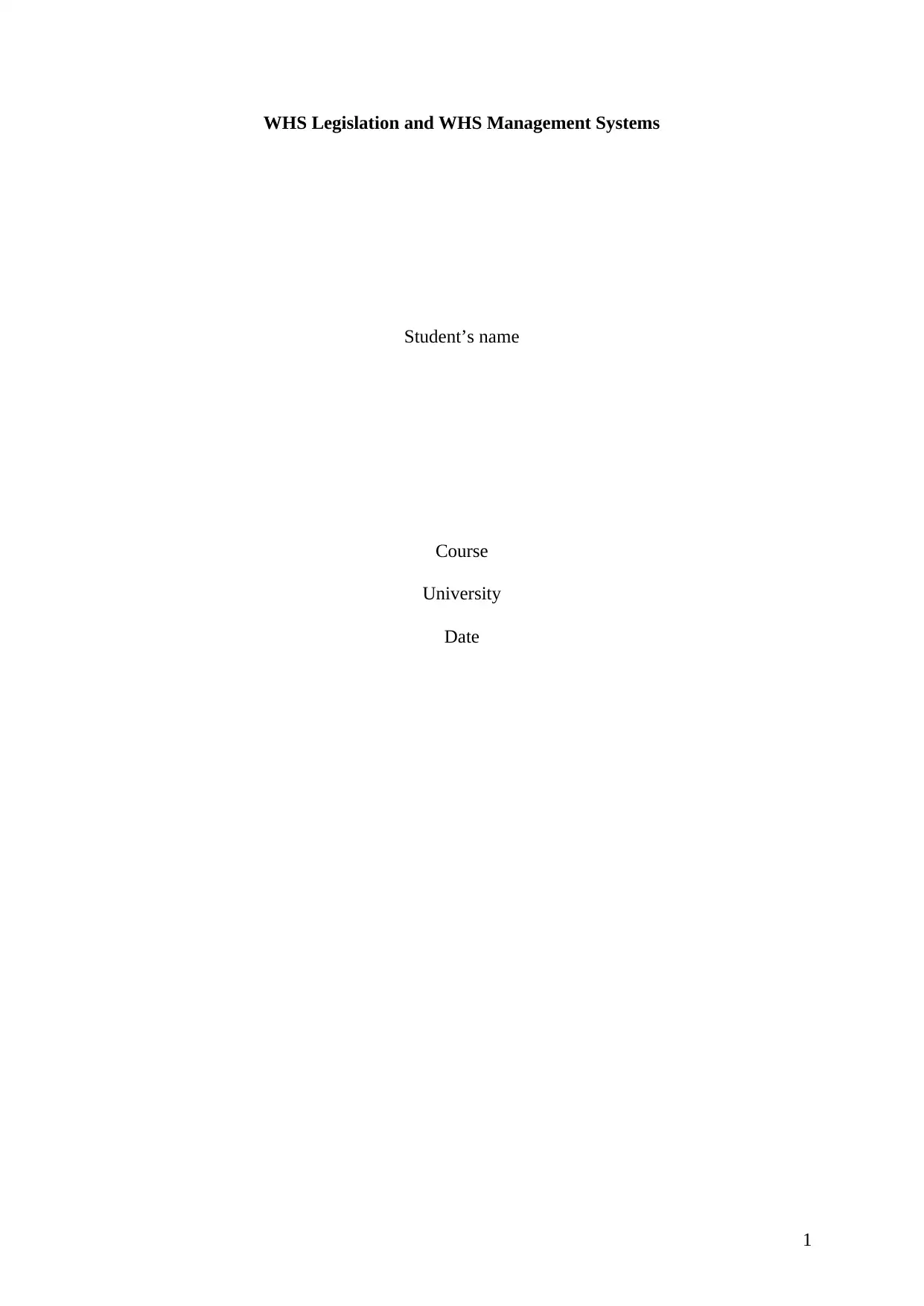
WHS Legislation and WHS Management Systems
Student’s name
Course
University
Date
1
Student’s name
Course
University
Date
1
Paraphrase This Document
Need a fresh take? Get an instant paraphrase of this document with our AI Paraphraser
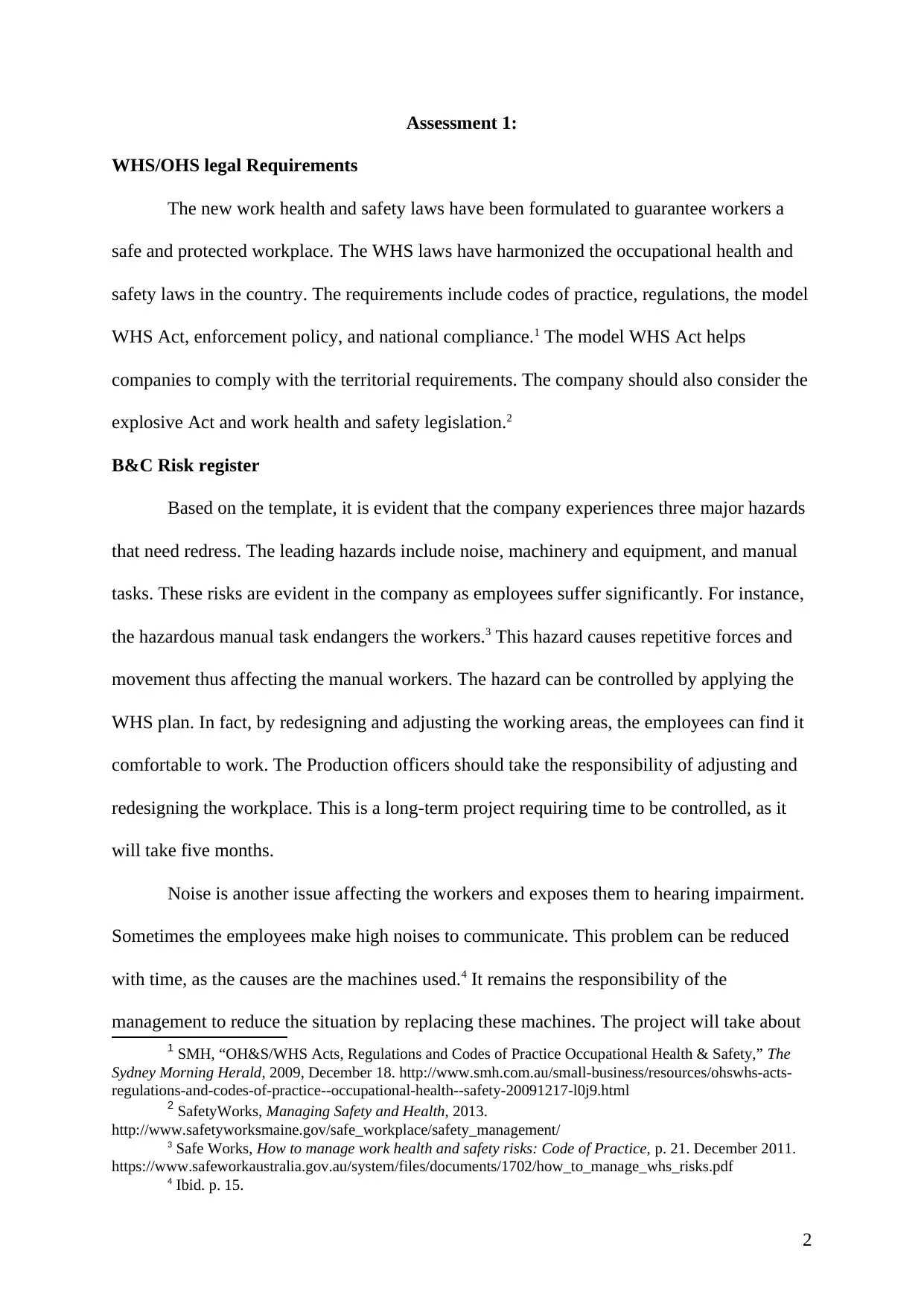
Assessment 1:
WHS/OHS legal Requirements
The new work health and safety laws have been formulated to guarantee workers a
safe and protected workplace. The WHS laws have harmonized the occupational health and
safety laws in the country. The requirements include codes of practice, regulations, the model
WHS Act, enforcement policy, and national compliance.1 The model WHS Act helps
companies to comply with the territorial requirements. The company should also consider the
explosive Act and work health and safety legislation.2
B&C Risk register
Based on the template, it is evident that the company experiences three major hazards
that need redress. The leading hazards include noise, machinery and equipment, and manual
tasks. These risks are evident in the company as employees suffer significantly. For instance,
the hazardous manual task endangers the workers.3 This hazard causes repetitive forces and
movement thus affecting the manual workers. The hazard can be controlled by applying the
WHS plan. In fact, by redesigning and adjusting the working areas, the employees can find it
comfortable to work. The Production officers should take the responsibility of adjusting and
redesigning the workplace. This is a long-term project requiring time to be controlled, as it
will take five months.
Noise is another issue affecting the workers and exposes them to hearing impairment.
Sometimes the employees make high noises to communicate. This problem can be reduced
with time, as the causes are the machines used.4 It remains the responsibility of the
management to reduce the situation by replacing these machines. The project will take about
1 SMH, “OH&S/WHS Acts, Regulations and Codes of Practice Occupational Health & Safety,” The
Sydney Morning Herald, 2009, December 18. http://www.smh.com.au/small-business/resources/ohswhs-acts-
regulations-and-codes-of-practice--occupational-health--safety-20091217-l0j9.html
2 SafetyWorks, Managing Safety and Health, 2013.
http://www.safetyworksmaine.gov/safe_workplace/safety_management/
3 Safe Works, How to manage work health and safety risks: Code of Practice, p. 21. December 2011.
https://www.safeworkaustralia.gov.au/system/files/documents/1702/how_to_manage_whs_risks.pdf
4 Ibid. p. 15.
2
WHS/OHS legal Requirements
The new work health and safety laws have been formulated to guarantee workers a
safe and protected workplace. The WHS laws have harmonized the occupational health and
safety laws in the country. The requirements include codes of practice, regulations, the model
WHS Act, enforcement policy, and national compliance.1 The model WHS Act helps
companies to comply with the territorial requirements. The company should also consider the
explosive Act and work health and safety legislation.2
B&C Risk register
Based on the template, it is evident that the company experiences three major hazards
that need redress. The leading hazards include noise, machinery and equipment, and manual
tasks. These risks are evident in the company as employees suffer significantly. For instance,
the hazardous manual task endangers the workers.3 This hazard causes repetitive forces and
movement thus affecting the manual workers. The hazard can be controlled by applying the
WHS plan. In fact, by redesigning and adjusting the working areas, the employees can find it
comfortable to work. The Production officers should take the responsibility of adjusting and
redesigning the workplace. This is a long-term project requiring time to be controlled, as it
will take five months.
Noise is another issue affecting the workers and exposes them to hearing impairment.
Sometimes the employees make high noises to communicate. This problem can be reduced
with time, as the causes are the machines used.4 It remains the responsibility of the
management to reduce the situation by replacing these machines. The project will take about
1 SMH, “OH&S/WHS Acts, Regulations and Codes of Practice Occupational Health & Safety,” The
Sydney Morning Herald, 2009, December 18. http://www.smh.com.au/small-business/resources/ohswhs-acts-
regulations-and-codes-of-practice--occupational-health--safety-20091217-l0j9.html
2 SafetyWorks, Managing Safety and Health, 2013.
http://www.safetyworksmaine.gov/safe_workplace/safety_management/
3 Safe Works, How to manage work health and safety risks: Code of Practice, p. 21. December 2011.
https://www.safeworkaustralia.gov.au/system/files/documents/1702/how_to_manage_whs_risks.pdf
4 Ibid. p. 15.
2
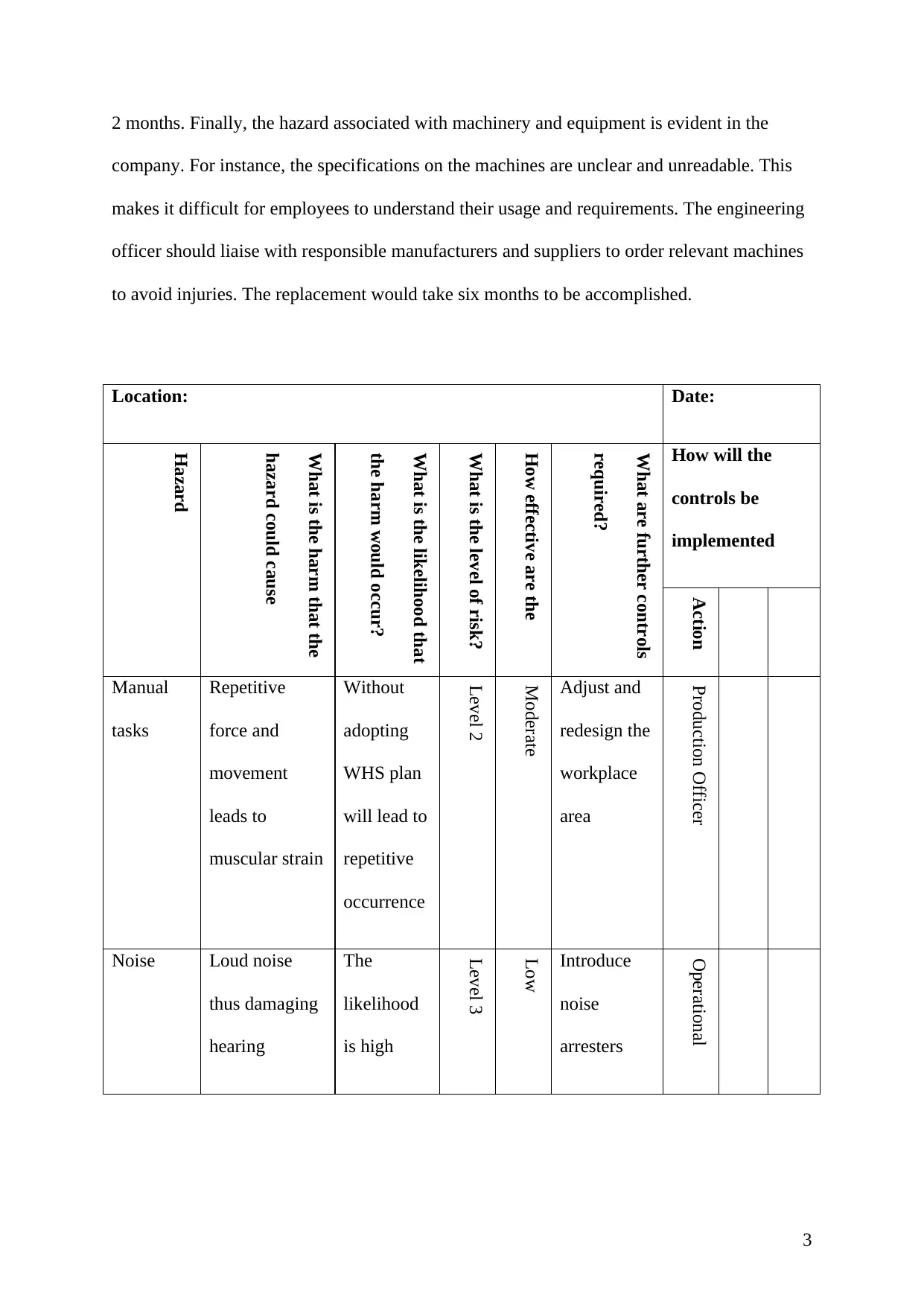
2 months. Finally, the hazard associated with machinery and equipment is evident in the
company. For instance, the specifications on the machines are unclear and unreadable. This
makes it difficult for employees to understand their usage and requirements. The engineering
officer should liaise with responsible manufacturers and suppliers to order relevant machines
to avoid injuries. The replacement would take six months to be accomplished.
Location: Date:
Hazard
What is the harm that the
hazard could cause
What is the likelihood that
the harm would occur?
What is the level of risk?
How effective are the
current controls?
What are further controls
required?
How will the
controls be
implemented
Action
by
Manual
tasks
Repetitive
force and
movement
leads to
muscular strain
Without
adopting
WHS plan
will lead to
repetitive
occurrence
Level 2
Moderate
Adjust and
redesign the
workplace
area
Production Officer
Noise Loud noise
thus damaging
hearing
The
likelihood
is high
Level 3
Low
Introduce
noise
arresters
Operational
officer
3
company. For instance, the specifications on the machines are unclear and unreadable. This
makes it difficult for employees to understand their usage and requirements. The engineering
officer should liaise with responsible manufacturers and suppliers to order relevant machines
to avoid injuries. The replacement would take six months to be accomplished.
Location: Date:
Hazard
What is the harm that the
hazard could cause
What is the likelihood that
the harm would occur?
What is the level of risk?
How effective are the
current controls?
What are further controls
required?
How will the
controls be
implemented
Action
by
Manual
tasks
Repetitive
force and
movement
leads to
muscular strain
Without
adopting
WHS plan
will lead to
repetitive
occurrence
Level 2
Moderate
Adjust and
redesign the
workplace
area
Production Officer
Noise Loud noise
thus damaging
hearing
The
likelihood
is high
Level 3
Low
Introduce
noise
arresters
Operational
officer
3
⊘ This is a preview!⊘
Do you want full access?
Subscribe today to unlock all pages.

Trusted by 1+ million students worldwide
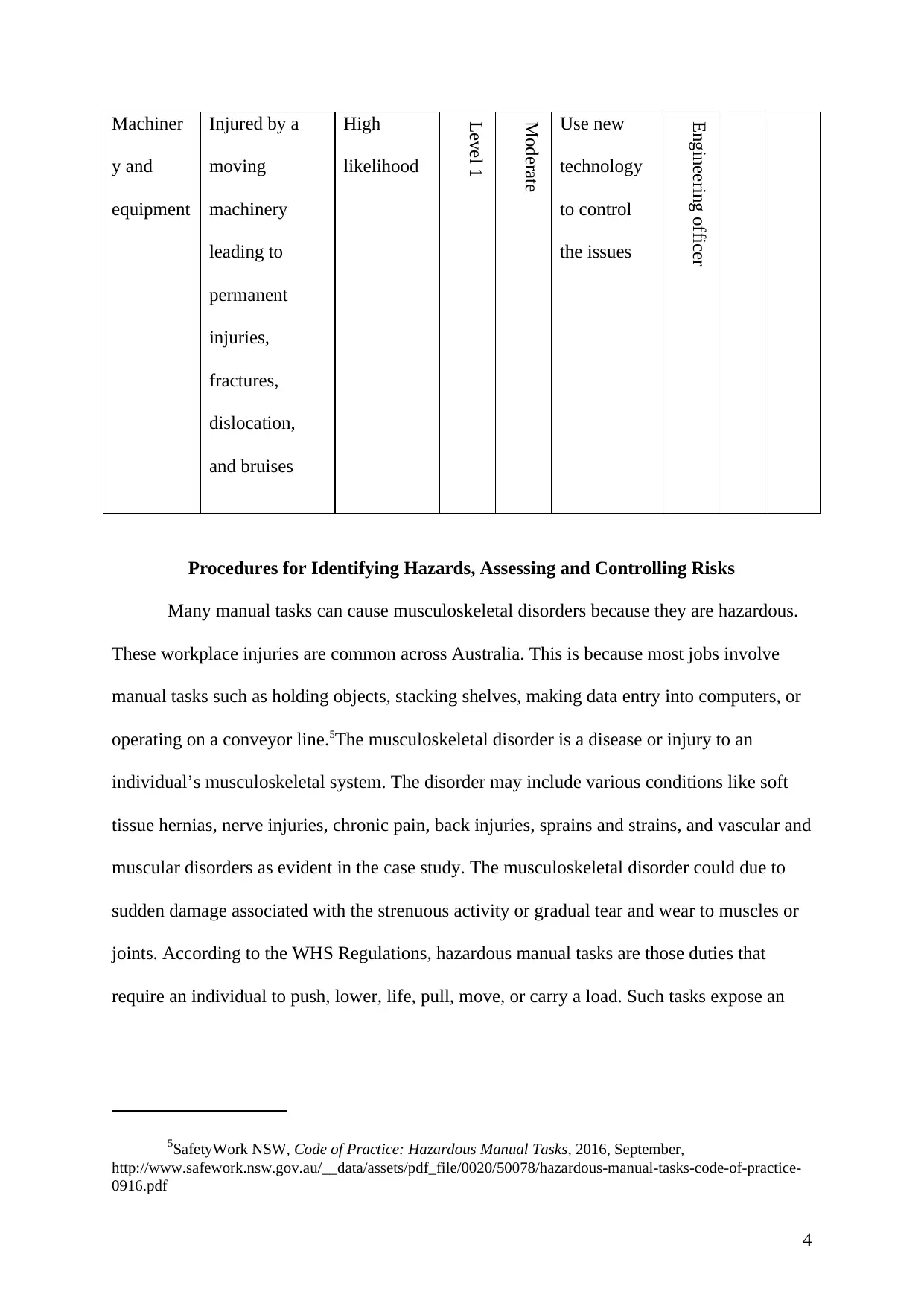
Machiner
y and
equipment
Injured by a
moving
machinery
leading to
permanent
injuries,
fractures,
dislocation,
and bruises
High
likelihood
Level 1
Moderate
Use new
technology
to control
the issues
Engineering officer
Procedures for Identifying Hazards, Assessing and Controlling Risks
Many manual tasks can cause musculoskeletal disorders because they are hazardous.
These workplace injuries are common across Australia. This is because most jobs involve
manual tasks such as holding objects, stacking shelves, making data entry into computers, or
operating on a conveyor line.5The musculoskeletal disorder is a disease or injury to an
individual’s musculoskeletal system. The disorder may include various conditions like soft
tissue hernias, nerve injuries, chronic pain, back injuries, sprains and strains, and vascular and
muscular disorders as evident in the case study. The musculoskeletal disorder could due to
sudden damage associated with the strenuous activity or gradual tear and wear to muscles or
joints. According to the WHS Regulations, hazardous manual tasks are those duties that
require an individual to push, lower, life, pull, move, or carry a load. Such tasks expose an
5SafetyWork NSW, Code of Practice: Hazardous Manual Tasks, 2016, September,
http://www.safework.nsw.gov.au/__data/assets/pdf_file/0020/50078/hazardous-manual-tasks-code-of-practice-
0916.pdf
4
y and
equipment
Injured by a
moving
machinery
leading to
permanent
injuries,
fractures,
dislocation,
and bruises
High
likelihood
Level 1
Moderate
Use new
technology
to control
the issues
Engineering officer
Procedures for Identifying Hazards, Assessing and Controlling Risks
Many manual tasks can cause musculoskeletal disorders because they are hazardous.
These workplace injuries are common across Australia. This is because most jobs involve
manual tasks such as holding objects, stacking shelves, making data entry into computers, or
operating on a conveyor line.5The musculoskeletal disorder is a disease or injury to an
individual’s musculoskeletal system. The disorder may include various conditions like soft
tissue hernias, nerve injuries, chronic pain, back injuries, sprains and strains, and vascular and
muscular disorders as evident in the case study. The musculoskeletal disorder could due to
sudden damage associated with the strenuous activity or gradual tear and wear to muscles or
joints. According to the WHS Regulations, hazardous manual tasks are those duties that
require an individual to push, lower, life, pull, move, or carry a load. Such tasks expose an
5SafetyWork NSW, Code of Practice: Hazardous Manual Tasks, 2016, September,
http://www.safework.nsw.gov.au/__data/assets/pdf_file/0020/50078/hazardous-manual-tasks-code-of-practice-
0916.pdf
4
Paraphrase This Document
Need a fresh take? Get an instant paraphrase of this document with our AI Paraphraser
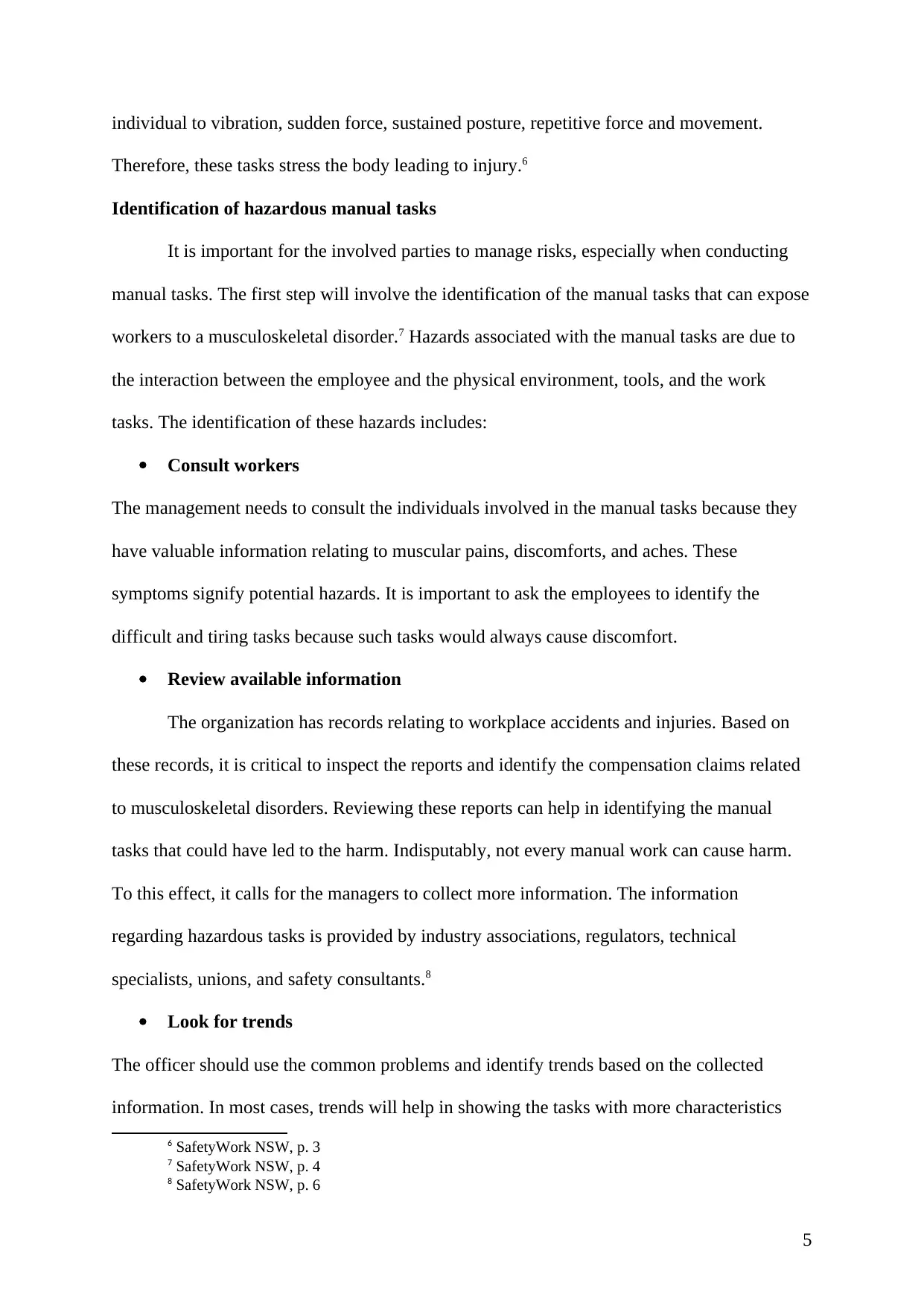
individual to vibration, sudden force, sustained posture, repetitive force and movement.
Therefore, these tasks stress the body leading to injury.6
Identification of hazardous manual tasks
It is important for the involved parties to manage risks, especially when conducting
manual tasks. The first step will involve the identification of the manual tasks that can expose
workers to a musculoskeletal disorder.7 Hazards associated with the manual tasks are due to
the interaction between the employee and the physical environment, tools, and the work
tasks. The identification of these hazards includes:
Consult workers
The management needs to consult the individuals involved in the manual tasks because they
have valuable information relating to muscular pains, discomforts, and aches. These
symptoms signify potential hazards. It is important to ask the employees to identify the
difficult and tiring tasks because such tasks would always cause discomfort.
Review available information
The organization has records relating to workplace accidents and injuries. Based on
these records, it is critical to inspect the reports and identify the compensation claims related
to musculoskeletal disorders. Reviewing these reports can help in identifying the manual
tasks that could have led to the harm. Indisputably, not every manual work can cause harm.
To this effect, it calls for the managers to collect more information. The information
regarding hazardous tasks is provided by industry associations, regulators, technical
specialists, unions, and safety consultants.8
Look for trends
The officer should use the common problems and identify trends based on the collected
information. In most cases, trends will help in showing the tasks with more characteristics
6 SafetyWork NSW, p. 3
7 SafetyWork NSW, p. 4
8 SafetyWork NSW, p. 6
5
Therefore, these tasks stress the body leading to injury.6
Identification of hazardous manual tasks
It is important for the involved parties to manage risks, especially when conducting
manual tasks. The first step will involve the identification of the manual tasks that can expose
workers to a musculoskeletal disorder.7 Hazards associated with the manual tasks are due to
the interaction between the employee and the physical environment, tools, and the work
tasks. The identification of these hazards includes:
Consult workers
The management needs to consult the individuals involved in the manual tasks because they
have valuable information relating to muscular pains, discomforts, and aches. These
symptoms signify potential hazards. It is important to ask the employees to identify the
difficult and tiring tasks because such tasks would always cause discomfort.
Review available information
The organization has records relating to workplace accidents and injuries. Based on
these records, it is critical to inspect the reports and identify the compensation claims related
to musculoskeletal disorders. Reviewing these reports can help in identifying the manual
tasks that could have led to the harm. Indisputably, not every manual work can cause harm.
To this effect, it calls for the managers to collect more information. The information
regarding hazardous tasks is provided by industry associations, regulators, technical
specialists, unions, and safety consultants.8
Look for trends
The officer should use the common problems and identify trends based on the collected
information. In most cases, trends will help in showing the tasks with more characteristics
6 SafetyWork NSW, p. 3
7 SafetyWork NSW, p. 4
8 SafetyWork NSW, p. 6
5
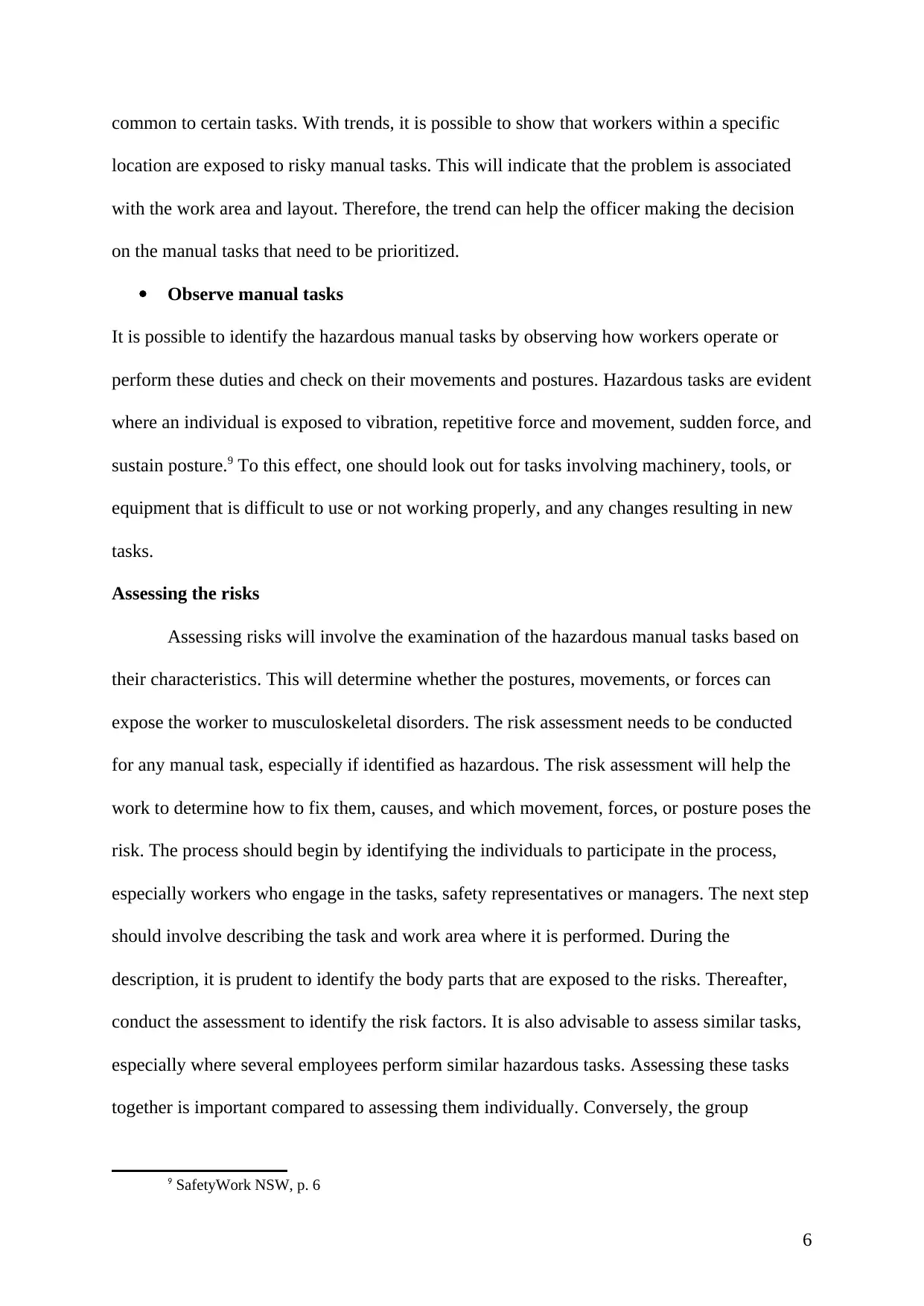
common to certain tasks. With trends, it is possible to show that workers within a specific
location are exposed to risky manual tasks. This will indicate that the problem is associated
with the work area and layout. Therefore, the trend can help the officer making the decision
on the manual tasks that need to be prioritized.
Observe manual tasks
It is possible to identify the hazardous manual tasks by observing how workers operate or
perform these duties and check on their movements and postures. Hazardous tasks are evident
where an individual is exposed to vibration, repetitive force and movement, sudden force, and
sustain posture.9 To this effect, one should look out for tasks involving machinery, tools, or
equipment that is difficult to use or not working properly, and any changes resulting in new
tasks.
Assessing the risks
Assessing risks will involve the examination of the hazardous manual tasks based on
their characteristics. This will determine whether the postures, movements, or forces can
expose the worker to musculoskeletal disorders. The risk assessment needs to be conducted
for any manual task, especially if identified as hazardous. The risk assessment will help the
work to determine how to fix them, causes, and which movement, forces, or posture poses the
risk. The process should begin by identifying the individuals to participate in the process,
especially workers who engage in the tasks, safety representatives or managers. The next step
should involve describing the task and work area where it is performed. During the
description, it is prudent to identify the body parts that are exposed to the risks. Thereafter,
conduct the assessment to identify the risk factors. It is also advisable to assess similar tasks,
especially where several employees perform similar hazardous tasks. Assessing these tasks
together is important compared to assessing them individually. Conversely, the group
9 SafetyWork NSW, p. 6
6
location are exposed to risky manual tasks. This will indicate that the problem is associated
with the work area and layout. Therefore, the trend can help the officer making the decision
on the manual tasks that need to be prioritized.
Observe manual tasks
It is possible to identify the hazardous manual tasks by observing how workers operate or
perform these duties and check on their movements and postures. Hazardous tasks are evident
where an individual is exposed to vibration, repetitive force and movement, sudden force, and
sustain posture.9 To this effect, one should look out for tasks involving machinery, tools, or
equipment that is difficult to use or not working properly, and any changes resulting in new
tasks.
Assessing the risks
Assessing risks will involve the examination of the hazardous manual tasks based on
their characteristics. This will determine whether the postures, movements, or forces can
expose the worker to musculoskeletal disorders. The risk assessment needs to be conducted
for any manual task, especially if identified as hazardous. The risk assessment will help the
work to determine how to fix them, causes, and which movement, forces, or posture poses the
risk. The process should begin by identifying the individuals to participate in the process,
especially workers who engage in the tasks, safety representatives or managers. The next step
should involve describing the task and work area where it is performed. During the
description, it is prudent to identify the body parts that are exposed to the risks. Thereafter,
conduct the assessment to identify the risk factors. It is also advisable to assess similar tasks,
especially where several employees perform similar hazardous tasks. Assessing these tasks
together is important compared to assessing them individually. Conversely, the group
9 SafetyWork NSW, p. 6
6
⊘ This is a preview!⊘
Do you want full access?
Subscribe today to unlock all pages.

Trusted by 1+ million students worldwide
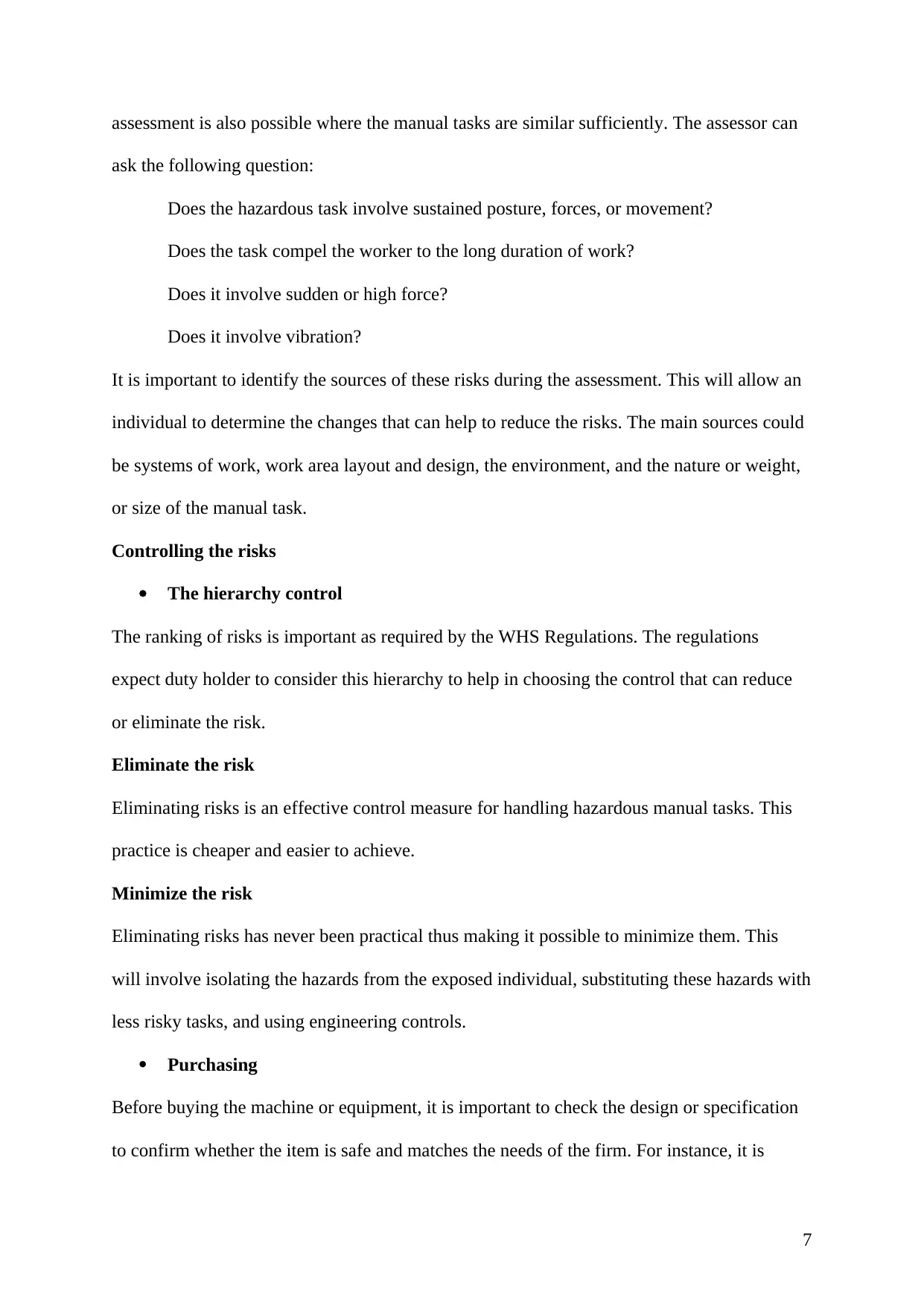
assessment is also possible where the manual tasks are similar sufficiently. The assessor can
ask the following question:
Does the hazardous task involve sustained posture, forces, or movement?
Does the task compel the worker to the long duration of work?
Does it involve sudden or high force?
Does it involve vibration?
It is important to identify the sources of these risks during the assessment. This will allow an
individual to determine the changes that can help to reduce the risks. The main sources could
be systems of work, work area layout and design, the environment, and the nature or weight,
or size of the manual task.
Controlling the risks
The hierarchy control
The ranking of risks is important as required by the WHS Regulations. The regulations
expect duty holder to consider this hierarchy to help in choosing the control that can reduce
or eliminate the risk.
Eliminate the risk
Eliminating risks is an effective control measure for handling hazardous manual tasks. This
practice is cheaper and easier to achieve.
Minimize the risk
Eliminating risks has never been practical thus making it possible to minimize them. This
will involve isolating the hazards from the exposed individual, substituting these hazards with
less risky tasks, and using engineering controls.
Purchasing
Before buying the machine or equipment, it is important to check the design or specification
to confirm whether the item is safe and matches the needs of the firm. For instance, it is
7
ask the following question:
Does the hazardous task involve sustained posture, forces, or movement?
Does the task compel the worker to the long duration of work?
Does it involve sudden or high force?
Does it involve vibration?
It is important to identify the sources of these risks during the assessment. This will allow an
individual to determine the changes that can help to reduce the risks. The main sources could
be systems of work, work area layout and design, the environment, and the nature or weight,
or size of the manual task.
Controlling the risks
The hierarchy control
The ranking of risks is important as required by the WHS Regulations. The regulations
expect duty holder to consider this hierarchy to help in choosing the control that can reduce
or eliminate the risk.
Eliminate the risk
Eliminating risks is an effective control measure for handling hazardous manual tasks. This
practice is cheaper and easier to achieve.
Minimize the risk
Eliminating risks has never been practical thus making it possible to minimize them. This
will involve isolating the hazards from the exposed individual, substituting these hazards with
less risky tasks, and using engineering controls.
Purchasing
Before buying the machine or equipment, it is important to check the design or specification
to confirm whether the item is safe and matches the needs of the firm. For instance, it is
7
Paraphrase This Document
Need a fresh take? Get an instant paraphrase of this document with our AI Paraphraser
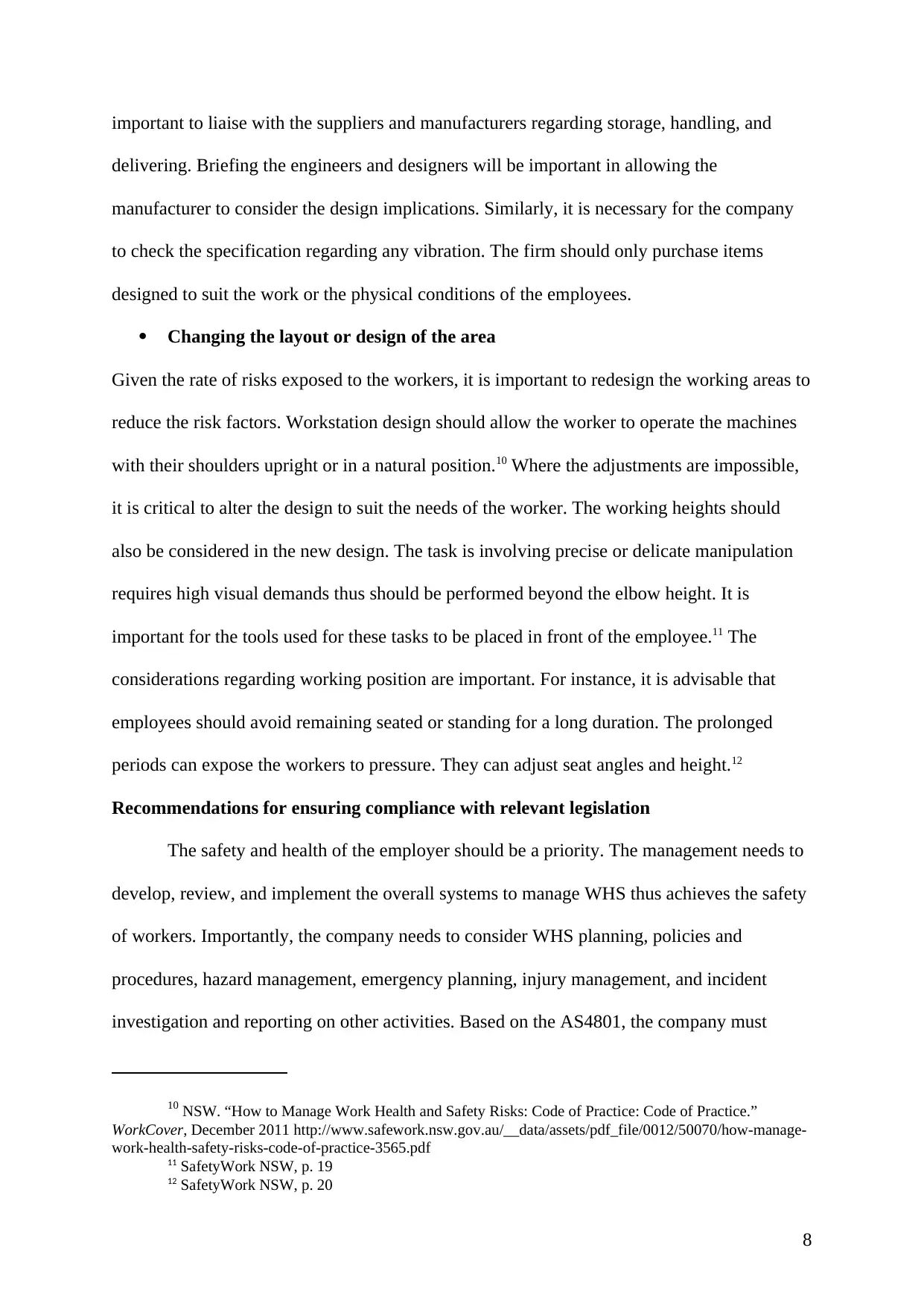
important to liaise with the suppliers and manufacturers regarding storage, handling, and
delivering. Briefing the engineers and designers will be important in allowing the
manufacturer to consider the design implications. Similarly, it is necessary for the company
to check the specification regarding any vibration. The firm should only purchase items
designed to suit the work or the physical conditions of the employees.
Changing the layout or design of the area
Given the rate of risks exposed to the workers, it is important to redesign the working areas to
reduce the risk factors. Workstation design should allow the worker to operate the machines
with their shoulders upright or in a natural position.10 Where the adjustments are impossible,
it is critical to alter the design to suit the needs of the worker. The working heights should
also be considered in the new design. The task is involving precise or delicate manipulation
requires high visual demands thus should be performed beyond the elbow height. It is
important for the tools used for these tasks to be placed in front of the employee.11 The
considerations regarding working position are important. For instance, it is advisable that
employees should avoid remaining seated or standing for a long duration. The prolonged
periods can expose the workers to pressure. They can adjust seat angles and height.12
Recommendations for ensuring compliance with relevant legislation
The safety and health of the employer should be a priority. The management needs to
develop, review, and implement the overall systems to manage WHS thus achieves the safety
of workers. Importantly, the company needs to consider WHS planning, policies and
procedures, hazard management, emergency planning, injury management, and incident
investigation and reporting on other activities. Based on the AS4801, the company must
10 NSW. “How to Manage Work Health and Safety Risks: Code of Practice: Code of Practice.”
WorkCover, December 2011 http://www.safework.nsw.gov.au/__data/assets/pdf_file/0012/50070/how-manage-
work-health-safety-risks-code-of-practice-3565.pdf
11 SafetyWork NSW, p. 19
12 SafetyWork NSW, p. 20
8
delivering. Briefing the engineers and designers will be important in allowing the
manufacturer to consider the design implications. Similarly, it is necessary for the company
to check the specification regarding any vibration. The firm should only purchase items
designed to suit the work or the physical conditions of the employees.
Changing the layout or design of the area
Given the rate of risks exposed to the workers, it is important to redesign the working areas to
reduce the risk factors. Workstation design should allow the worker to operate the machines
with their shoulders upright or in a natural position.10 Where the adjustments are impossible,
it is critical to alter the design to suit the needs of the worker. The working heights should
also be considered in the new design. The task is involving precise or delicate manipulation
requires high visual demands thus should be performed beyond the elbow height. It is
important for the tools used for these tasks to be placed in front of the employee.11 The
considerations regarding working position are important. For instance, it is advisable that
employees should avoid remaining seated or standing for a long duration. The prolonged
periods can expose the workers to pressure. They can adjust seat angles and height.12
Recommendations for ensuring compliance with relevant legislation
The safety and health of the employer should be a priority. The management needs to
develop, review, and implement the overall systems to manage WHS thus achieves the safety
of workers. Importantly, the company needs to consider WHS planning, policies and
procedures, hazard management, emergency planning, injury management, and incident
investigation and reporting on other activities. Based on the AS4801, the company must
10 NSW. “How to Manage Work Health and Safety Risks: Code of Practice: Code of Practice.”
WorkCover, December 2011 http://www.safework.nsw.gov.au/__data/assets/pdf_file/0012/50070/how-manage-
work-health-safety-risks-code-of-practice-3565.pdf
11 SafetyWork NSW, p. 19
12 SafetyWork NSW, p. 20
8
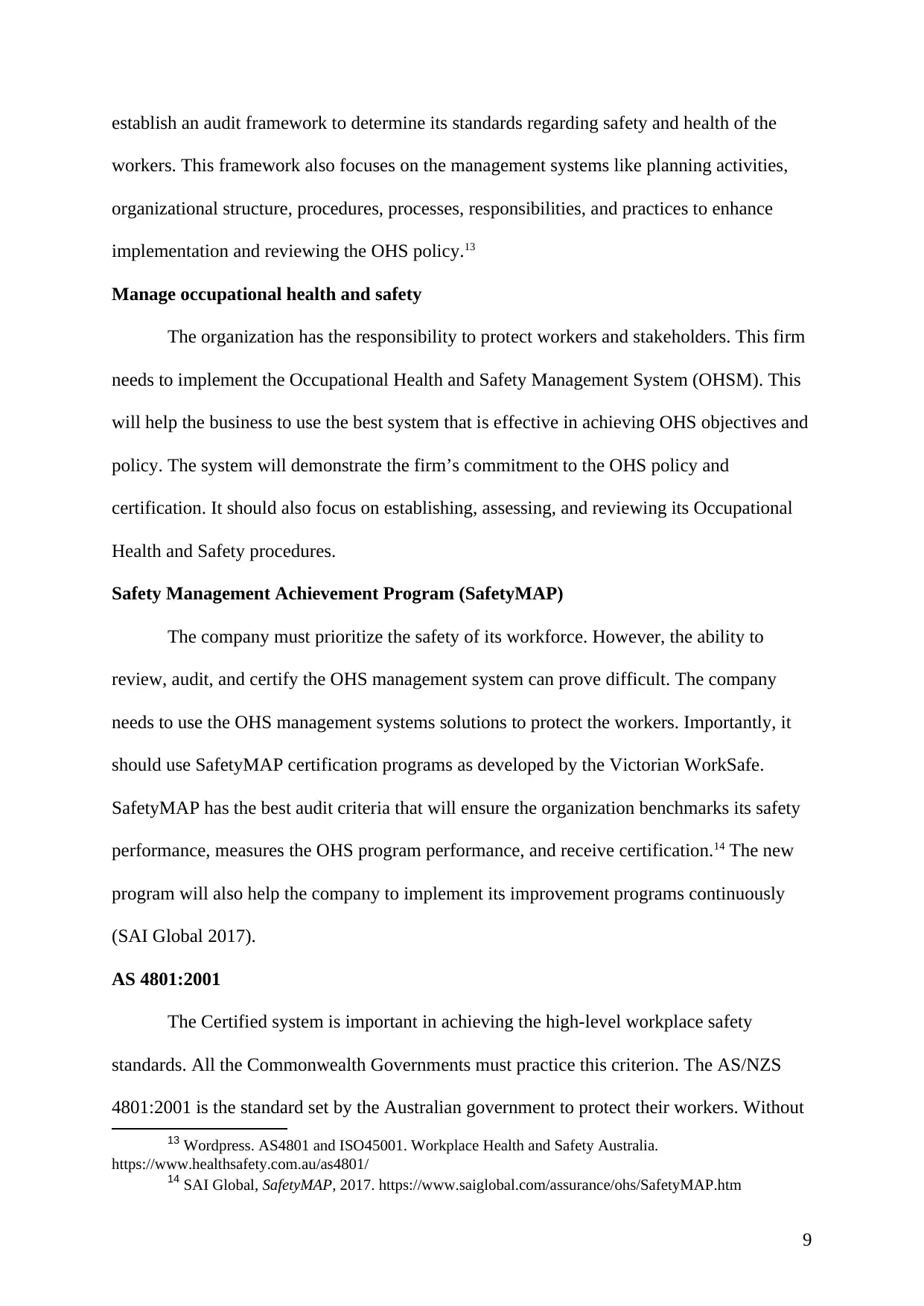
establish an audit framework to determine its standards regarding safety and health of the
workers. This framework also focuses on the management systems like planning activities,
organizational structure, procedures, processes, responsibilities, and practices to enhance
implementation and reviewing the OHS policy.13
Manage occupational health and safety
The organization has the responsibility to protect workers and stakeholders. This firm
needs to implement the Occupational Health and Safety Management System (OHSM). This
will help the business to use the best system that is effective in achieving OHS objectives and
policy. The system will demonstrate the firm’s commitment to the OHS policy and
certification. It should also focus on establishing, assessing, and reviewing its Occupational
Health and Safety procedures.
Safety Management Achievement Program (SafetyMAP)
The company must prioritize the safety of its workforce. However, the ability to
review, audit, and certify the OHS management system can prove difficult. The company
needs to use the OHS management systems solutions to protect the workers. Importantly, it
should use SafetyMAP certification programs as developed by the Victorian WorkSafe.
SafetyMAP has the best audit criteria that will ensure the organization benchmarks its safety
performance, measures the OHS program performance, and receive certification.14 The new
program will also help the company to implement its improvement programs continuously
(SAI Global 2017).
AS 4801:2001
The Certified system is important in achieving the high-level workplace safety
standards. All the Commonwealth Governments must practice this criterion. The AS/NZS
4801:2001 is the standard set by the Australian government to protect their workers. Without
13 Wordpress. AS4801 and ISO45001. Workplace Health and Safety Australia.
https://www.healthsafety.com.au/as4801/
14 SAI Global, SafetyMAP, 2017. https://www.saiglobal.com/assurance/ohs/SafetyMAP.htm
9
workers. This framework also focuses on the management systems like planning activities,
organizational structure, procedures, processes, responsibilities, and practices to enhance
implementation and reviewing the OHS policy.13
Manage occupational health and safety
The organization has the responsibility to protect workers and stakeholders. This firm
needs to implement the Occupational Health and Safety Management System (OHSM). This
will help the business to use the best system that is effective in achieving OHS objectives and
policy. The system will demonstrate the firm’s commitment to the OHS policy and
certification. It should also focus on establishing, assessing, and reviewing its Occupational
Health and Safety procedures.
Safety Management Achievement Program (SafetyMAP)
The company must prioritize the safety of its workforce. However, the ability to
review, audit, and certify the OHS management system can prove difficult. The company
needs to use the OHS management systems solutions to protect the workers. Importantly, it
should use SafetyMAP certification programs as developed by the Victorian WorkSafe.
SafetyMAP has the best audit criteria that will ensure the organization benchmarks its safety
performance, measures the OHS program performance, and receive certification.14 The new
program will also help the company to implement its improvement programs continuously
(SAI Global 2017).
AS 4801:2001
The Certified system is important in achieving the high-level workplace safety
standards. All the Commonwealth Governments must practice this criterion. The AS/NZS
4801:2001 is the standard set by the Australian government to protect their workers. Without
13 Wordpress. AS4801 and ISO45001. Workplace Health and Safety Australia.
https://www.healthsafety.com.au/as4801/
14 SAI Global, SafetyMAP, 2017. https://www.saiglobal.com/assurance/ohs/SafetyMAP.htm
9
⊘ This is a preview!⊘
Do you want full access?
Subscribe today to unlock all pages.

Trusted by 1+ million students worldwide
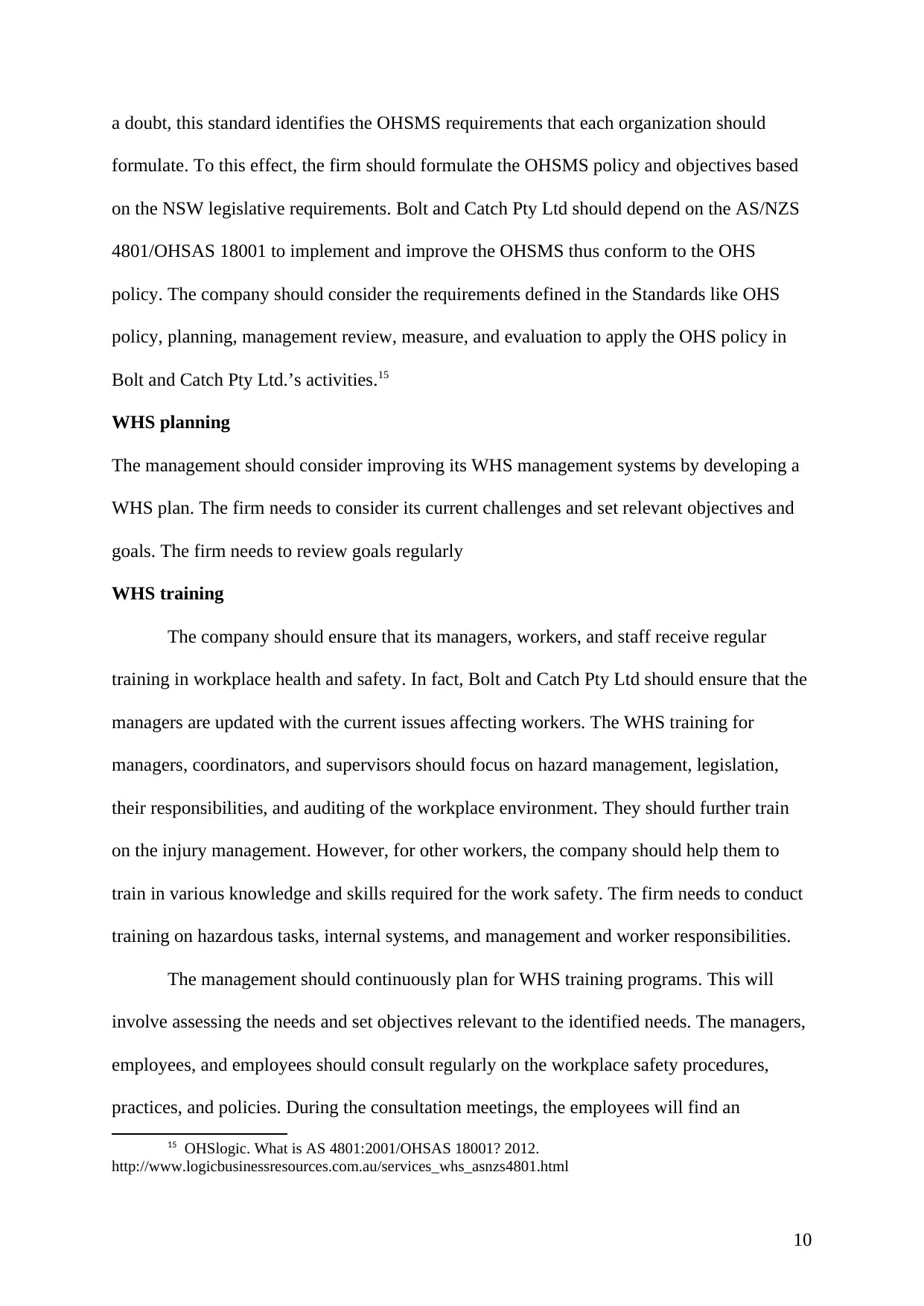
a doubt, this standard identifies the OHSMS requirements that each organization should
formulate. To this effect, the firm should formulate the OHSMS policy and objectives based
on the NSW legislative requirements. Bolt and Catch Pty Ltd should depend on the AS/NZS
4801/OHSAS 18001 to implement and improve the OHSMS thus conform to the OHS
policy. The company should consider the requirements defined in the Standards like OHS
policy, planning, management review, measure, and evaluation to apply the OHS policy in
Bolt and Catch Pty Ltd.’s activities.15
WHS planning
The management should consider improving its WHS management systems by developing a
WHS plan. The firm needs to consider its current challenges and set relevant objectives and
goals. The firm needs to review goals regularly
WHS training
The company should ensure that its managers, workers, and staff receive regular
training in workplace health and safety. In fact, Bolt and Catch Pty Ltd should ensure that the
managers are updated with the current issues affecting workers. The WHS training for
managers, coordinators, and supervisors should focus on hazard management, legislation,
their responsibilities, and auditing of the workplace environment. They should further train
on the injury management. However, for other workers, the company should help them to
train in various knowledge and skills required for the work safety. The firm needs to conduct
training on hazardous tasks, internal systems, and management and worker responsibilities.
The management should continuously plan for WHS training programs. This will
involve assessing the needs and set objectives relevant to the identified needs. The managers,
employees, and employees should consult regularly on the workplace safety procedures,
practices, and policies. During the consultation meetings, the employees will find an
15 OHSlogic. What is AS 4801:2001/OHSAS 18001? 2012.
http://www.logicbusinessresources.com.au/services_whs_asnzs4801.html
10
formulate. To this effect, the firm should formulate the OHSMS policy and objectives based
on the NSW legislative requirements. Bolt and Catch Pty Ltd should depend on the AS/NZS
4801/OHSAS 18001 to implement and improve the OHSMS thus conform to the OHS
policy. The company should consider the requirements defined in the Standards like OHS
policy, planning, management review, measure, and evaluation to apply the OHS policy in
Bolt and Catch Pty Ltd.’s activities.15
WHS planning
The management should consider improving its WHS management systems by developing a
WHS plan. The firm needs to consider its current challenges and set relevant objectives and
goals. The firm needs to review goals regularly
WHS training
The company should ensure that its managers, workers, and staff receive regular
training in workplace health and safety. In fact, Bolt and Catch Pty Ltd should ensure that the
managers are updated with the current issues affecting workers. The WHS training for
managers, coordinators, and supervisors should focus on hazard management, legislation,
their responsibilities, and auditing of the workplace environment. They should further train
on the injury management. However, for other workers, the company should help them to
train in various knowledge and skills required for the work safety. The firm needs to conduct
training on hazardous tasks, internal systems, and management and worker responsibilities.
The management should continuously plan for WHS training programs. This will
involve assessing the needs and set objectives relevant to the identified needs. The managers,
employees, and employees should consult regularly on the workplace safety procedures,
practices, and policies. During the consultation meetings, the employees will find an
15 OHSlogic. What is AS 4801:2001/OHSAS 18001? 2012.
http://www.logicbusinessresources.com.au/services_whs_asnzs4801.html
10
Paraphrase This Document
Need a fresh take? Get an instant paraphrase of this document with our AI Paraphraser
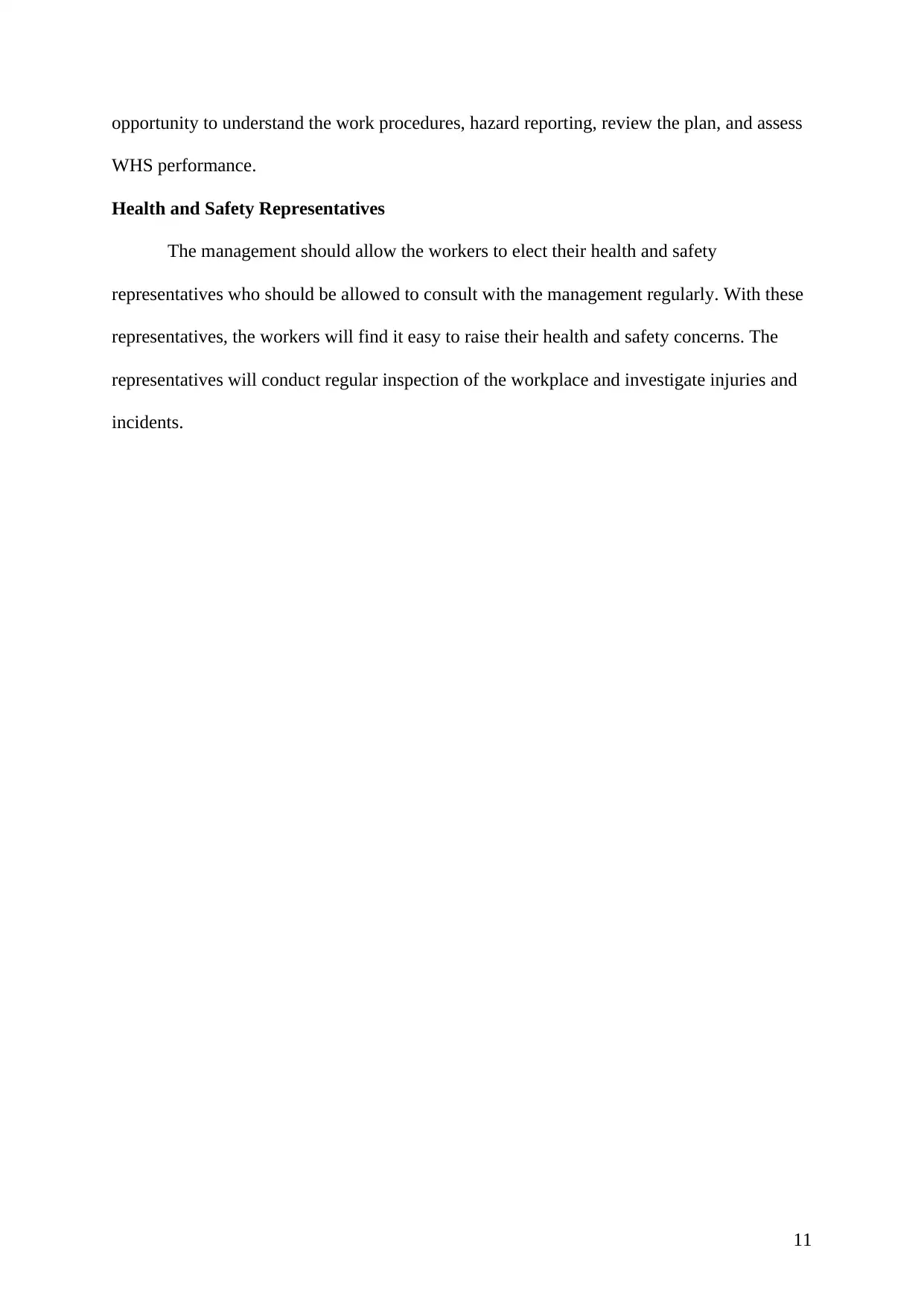
opportunity to understand the work procedures, hazard reporting, review the plan, and assess
WHS performance.
Health and Safety Representatives
The management should allow the workers to elect their health and safety
representatives who should be allowed to consult with the management regularly. With these
representatives, the workers will find it easy to raise their health and safety concerns. The
representatives will conduct regular inspection of the workplace and investigate injuries and
incidents.
11
WHS performance.
Health and Safety Representatives
The management should allow the workers to elect their health and safety
representatives who should be allowed to consult with the management regularly. With these
representatives, the workers will find it easy to raise their health and safety concerns. The
representatives will conduct regular inspection of the workplace and investigate injuries and
incidents.
11
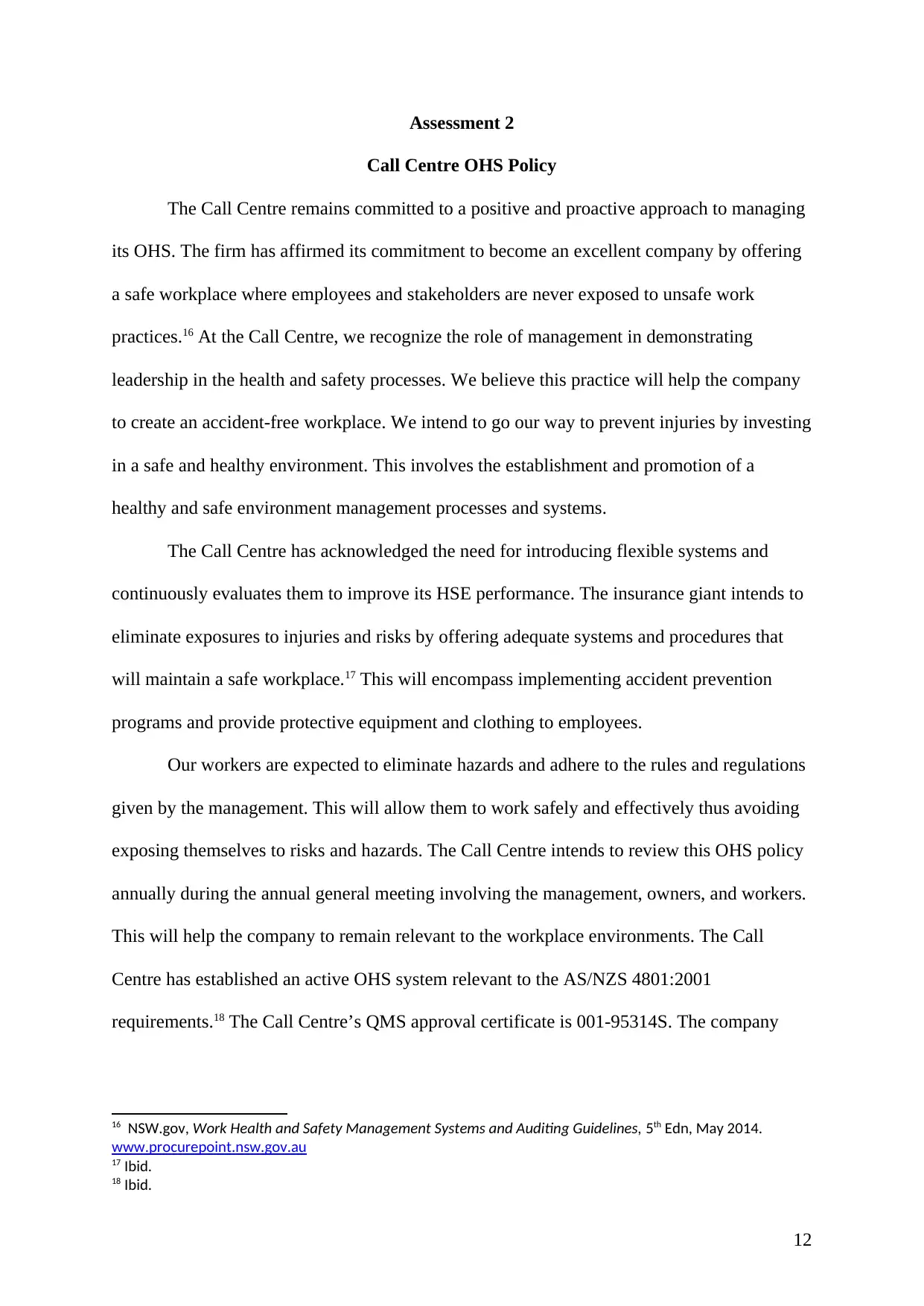
Assessment 2
Call Centre OHS Policy
The Call Centre remains committed to a positive and proactive approach to managing
its OHS. The firm has affirmed its commitment to become an excellent company by offering
a safe workplace where employees and stakeholders are never exposed to unsafe work
practices.16 At the Call Centre, we recognize the role of management in demonstrating
leadership in the health and safety processes. We believe this practice will help the company
to create an accident-free workplace. We intend to go our way to prevent injuries by investing
in a safe and healthy environment. This involves the establishment and promotion of a
healthy and safe environment management processes and systems.
The Call Centre has acknowledged the need for introducing flexible systems and
continuously evaluates them to improve its HSE performance. The insurance giant intends to
eliminate exposures to injuries and risks by offering adequate systems and procedures that
will maintain a safe workplace.17 This will encompass implementing accident prevention
programs and provide protective equipment and clothing to employees.
Our workers are expected to eliminate hazards and adhere to the rules and regulations
given by the management. This will allow them to work safely and effectively thus avoiding
exposing themselves to risks and hazards. The Call Centre intends to review this OHS policy
annually during the annual general meeting involving the management, owners, and workers.
This will help the company to remain relevant to the workplace environments. The Call
Centre has established an active OHS system relevant to the AS/NZS 4801:2001
requirements.18 The Call Centre’s QMS approval certificate is 001-95314S. The company
16 NSW.gov, Work Health and Safety Management Systems and Auditing Guidelines, 5th Edn, May 2014.
www.procurepoint.nsw.gov.au
17 Ibid.
18 Ibid.
12
Call Centre OHS Policy
The Call Centre remains committed to a positive and proactive approach to managing
its OHS. The firm has affirmed its commitment to become an excellent company by offering
a safe workplace where employees and stakeholders are never exposed to unsafe work
practices.16 At the Call Centre, we recognize the role of management in demonstrating
leadership in the health and safety processes. We believe this practice will help the company
to create an accident-free workplace. We intend to go our way to prevent injuries by investing
in a safe and healthy environment. This involves the establishment and promotion of a
healthy and safe environment management processes and systems.
The Call Centre has acknowledged the need for introducing flexible systems and
continuously evaluates them to improve its HSE performance. The insurance giant intends to
eliminate exposures to injuries and risks by offering adequate systems and procedures that
will maintain a safe workplace.17 This will encompass implementing accident prevention
programs and provide protective equipment and clothing to employees.
Our workers are expected to eliminate hazards and adhere to the rules and regulations
given by the management. This will allow them to work safely and effectively thus avoiding
exposing themselves to risks and hazards. The Call Centre intends to review this OHS policy
annually during the annual general meeting involving the management, owners, and workers.
This will help the company to remain relevant to the workplace environments. The Call
Centre has established an active OHS system relevant to the AS/NZS 4801:2001
requirements.18 The Call Centre’s QMS approval certificate is 001-95314S. The company
16 NSW.gov, Work Health and Safety Management Systems and Auditing Guidelines, 5th Edn, May 2014.
www.procurepoint.nsw.gov.au
17 Ibid.
18 Ibid.
12
⊘ This is a preview!⊘
Do you want full access?
Subscribe today to unlock all pages.

Trusted by 1+ million students worldwide
1 out of 25
Related Documents
Your All-in-One AI-Powered Toolkit for Academic Success.
+13062052269
info@desklib.com
Available 24*7 on WhatsApp / Email
![[object Object]](/_next/static/media/star-bottom.7253800d.svg)
Unlock your academic potential
Copyright © 2020–2025 A2Z Services. All Rights Reserved. Developed and managed by ZUCOL.





